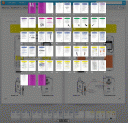Each semester I tweak my Business & Design class as I learn more about how to teach undergrad design students about business, and help them to blend business and design ideas rather than see them as two separate spheres (while relating cautionary tales, as with Ford bean counters who show up at the end and revise the design!).
This semester culminated with a poster that could encapsulate the artifact, consumer experience, and business model on one sheet of paper. Once we had all this information in one place, we could see that, for example, it wasn’t going to make enough money, and then use our research and idea generation techniques to tweak some aspect, such as the price, and watch how it changed other aspects, like the target audience.
For a one semester course, it was a lot for them to absorb, and the results will still look elementary to professionals, but they rose to the challenge and I think this format has potential to help designers and businesspeople see the connection between form, function, audience, costs, revenue, and business model.
Here’s three examples. Click through the link to see the high-res versions.









